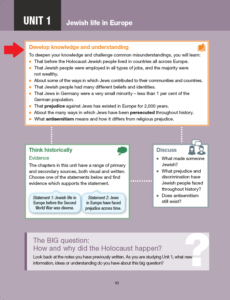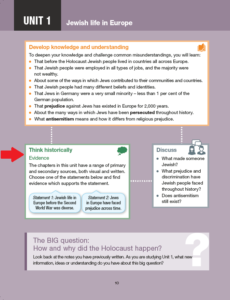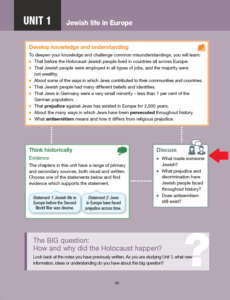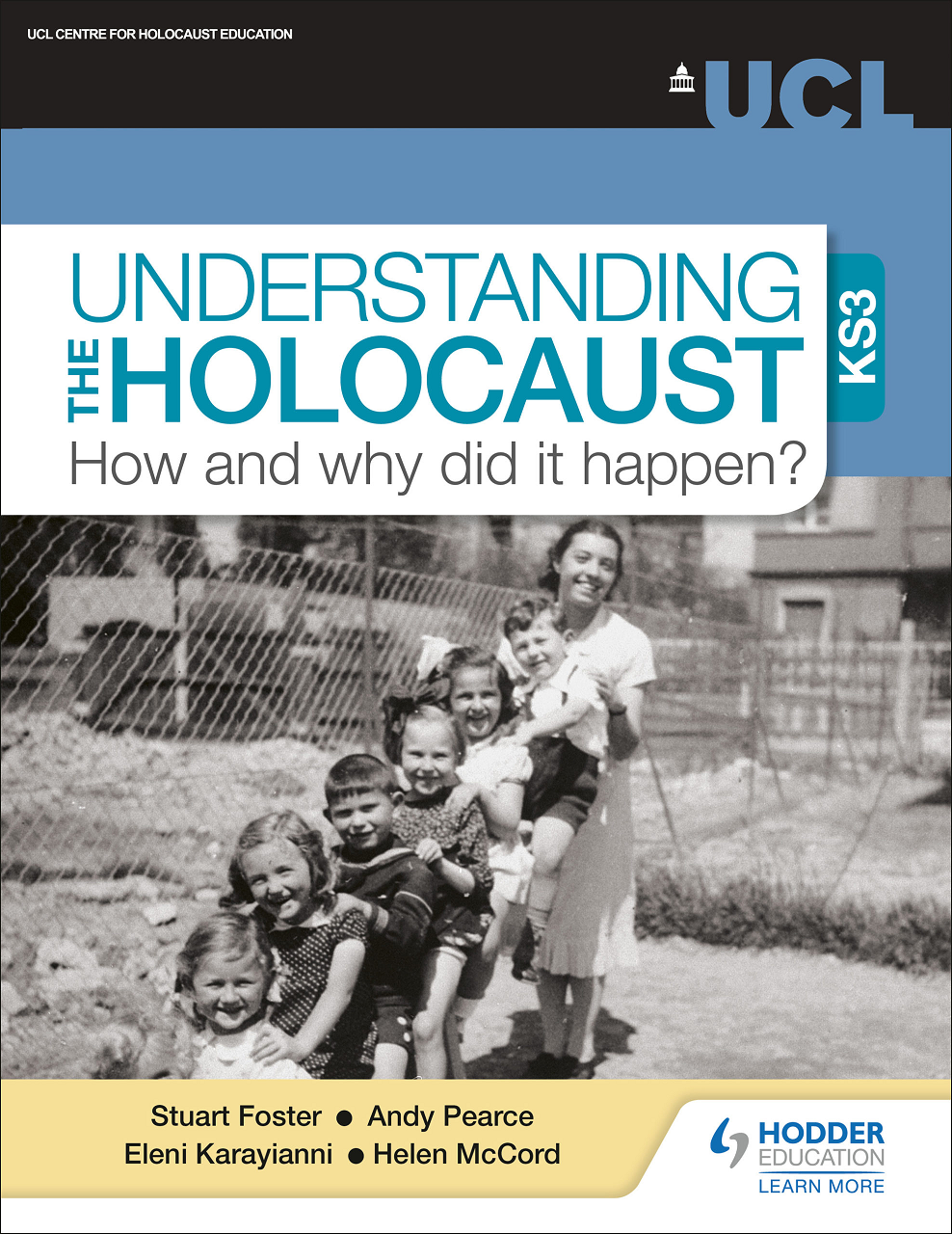AIMS OF TEACHER GUIDANCE
The aim of these guidance materials is to provide support for teachers using the UCL Centre for Holocaust Education KS3 textbook ‘Understanding the Holocaust’ with their students within their programme of Holocaust education. All of our resources and guidance materials uphold the pedagogical principles that underpin the textbook. It aims to:
- Deepen student knowledge and understanding of the Holocaust and encourage student enquiry and critical thinking.
- Challenge the key myths and misconceptions around the Holocaust as identified in our ground breaking research and other common misunderstandings as identified through our experience in Holocaust education. Read our research briefing here.
- Humanise the victims of the Holocaust, by recognising that all victims of the Holocaust were individuals with agency, with lives before the Holocaust, using personal experiences and accounts throughout in a sensitive way.
- Demystify the perpetrators, by using case studies that show that the murder and persecution of the Jews of Europe was committed by a wide range and number of individuals, organisations and regimes, encouraging reflection upon issues of responsibility and complicity.
- Respect the International Holocaust Remembrance Alliance recommendations for teaching and learning about the Holocaust.
To support you as you use the textbook in the classroom these guidance materials provide the following:
- Access to our online CPD courses: Access our online CPD courses to enrich your subject knowledge and explore effective pedagogical approaches to teaching about the Holocaust.
- Access to UCL CfHE classroom materials and online lesson materials: Access our lesson materials, resources and lesson plans which are based on empirical research into classroom needs and informed by the latest in Holocaust pedagogy.
- Support for further student enquiry: Link to partner organisations to access suitable materials and resources to support your students with further enquiry into some of the issues raised in the textbook.
- Guidance for recommended further reading materials: View recommended further reading materials to enrich your subject knowledge of the Holocaust and engage with some of the latest Holocaust scholarship.
- Access to supporting student materials: Access resource materials linked to the textbook to support your students in reflecting upon and securing their knowledge and understanding of the Holocaust.
Research informed:
This textbook was written in direct response to the results of the Centre’s 2016 research and landmark study ‘What do students know and understand about the Holocaust?’. Our research identified a number of student misconceptions and misunderstandings. Further common misunderstandings have been identified through our experience in the field of Holocaust education. On each unit overview page there is a ‘Develop knowledge and understanding’ section. Here we have summarised the key knowledge and understanding that students will develop as they work through each unit, enabling them to challenge those misconceptions and misunderstandings that we have identified.
In each chapter section in this guidance, where it is applicable, you will also find a summary of the key myths and misconceptions identified in our research. We explicitly aim to challenge these in each textbook chapter and through our supporting materials. Should you choose to share these with students it is very important to be clear that these are false statements and they need to be taught about with sensitivity and skill.
Additionally and where relevant, in each chapter section in this guidance you will find a link to our appropriate research briefing document.

ASSESSMENT
What is our approach to assessment?
Throughout the textbook we have included various activities that are meaningful, rigorous, encourage historical thinking and enable teachers to assess the knowledge and understanding of their students as they progress through the units and individual chapters. There are six thematic units in the textbook which are organised chronologically. The following assessments are a feature of each unit:
In each unit:
Think historically task: On each unit overview page there is a ‘Think historically’ task. These tasks enable you to assess the historical understanding that your students will develop through studying this Unit of the textbook. Each ‘Think Historically’ task addresses a second order concept such as chronology, change and continuity, significance or interpretation.

The BIG question: On each unit overview page for units 1 – 5 there is a section relating to the BIG question ‘How and why did the Holocaust happen?’ The textbook is designed to help your students to answer both of these important questions. As students work through the textbook they will build upon their knowledge and understanding of the Holocaust which will enable them to answer these questions in more detailed and rigorous ways. In this guidance you can access ‘Knowledge and understanding organisers’. These will allow your students to organise the new knowledge that they gain from each unit and to reflect upon their understanding and their emerging response to the BIG question at regular intervals.

DOWNLOAD: Knowledge and Understanding Organisers Introduction
DOWNLOAD: Knowledge and Understanding Organisers Units 1 to 5
DOWNLOAD: The BIG question writing frame
Discuss: On each unit overview page there is a section entitled ‘Discuss’. We have identified some important questions that you may wish to explore and discuss further with your students. Successful classroom discussion around some of these issues and others raised in the textbook require a safe space for free expression where evidence and truth are respected. It is important to be explicit about classroom expectations in such a scenario, and to model to your students an appropriate way of discussing this highly sensitive subject. You should be explicit about the expectations of such a discussion and may wish to develop a class agreement or written document for your students to read and refer to.

In each chapter:
Think About: Throughout the textbook there are a range of ‘Think About’ activities. The aim of these is to provide an opportunity for students to reflect upon and consider some of the complex issues raised by the textbook chapter content. They enable students to secure their understanding of the key knowledge that the chapter has introduced. Some of these ‘Think About’ activities also provide an opportunity for cross curricular delivery of Holocaust education. They encourage the exploration of issues that may be raised in the RS, Citizenship and PSHE classrooms, for example, the complexities of resistance, responsibility and justice. In the chapter sections of this guidance you will find supporting materials for both students and teachers to assist with some of these ‘Think About’ activities.
Activities: Within each chapter there are a range of ‘Activities’. The aim of these is to provide an opportunity at regular intervals for students to consolidate the key knowledge and understanding that they have gained from each chapter. They allow teachers to regularly assess student progress and they encourage further student reflection and engagement with many of the complex issues raised by the content of the chapter. The ‘Activities’ assess a range of skills; including the use of historical second order concepts such as change and continuity, significance and interpretations. In the chapter sections of this guidance you will find supporting materials for both students and teachers to assist with some of these ‘Activities’.
A number of ‘Activities’ throughout the textbook require students to undertake further research into an individual, an event or a concept. When facilitating this opportunity for your students it is important to be mindful of ICT safeguarding procedures. Given the nature of some of the materials that students may encounter when undertaking online research about the Holocaust and related issues we strongly recommend that you direct students to the recommended sites and organisations for which we have provided links. You will find these recommendations within the relevant chapter sections of this guidance.
Glossary of terms:
DOWNLOAD: Printable Glossary of Terms
Online Knowledge Checks
At the end of each unit there is a link to our website where your students will be able complete a short multiple choice questionnaire. These questionnaires include the questions that we asked students in our 2016 student research. This will be available soon for you to use with your students.
TEACHER RESOURCE SHARING HUB
We want to hear from you!
As part of these guidance materials we want to develop an area where teachers can share feedback, top tips, useful resources and lesson materials that have been developed in response to the textbook.
If you would like to find out more about this exciting opportunity please contact helen.mccord@ucl.ac.uk

